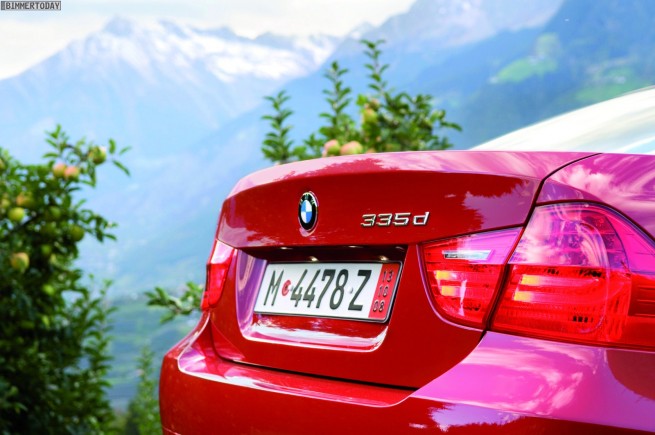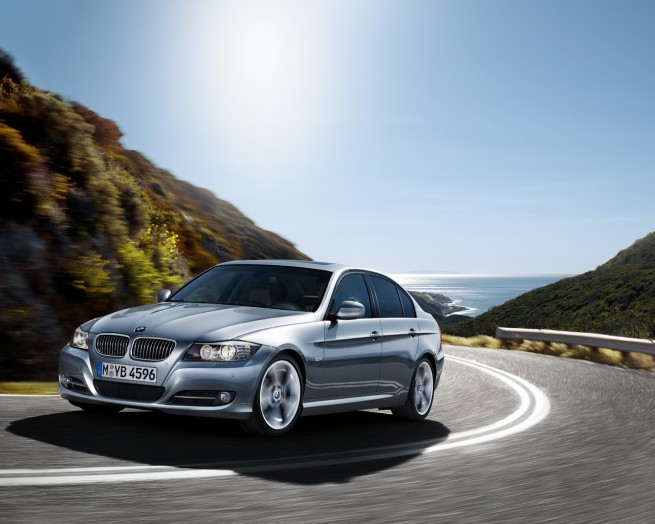BMW 335d 18-Month Report and Review
Sunday, June 5, 2011 by Anonymous
The Diesel Driver delivers their 18-month report on the BMW 335d.
“While the unusually snowy winter in New York resulted in the cancellation of several longer driving trips, the 335d did quite well in the snow, thanks in part to the Pirelli Winter 210 Sottozero winter performance tires. In a 12-month period, the 335d drove to Lindau, Berchtesgaden, Roßfeld, and Graz before being shipped to the U.S. More recenty, it’s been to Philadelphia, the Poconos, and New England. It even made it to Lime Rock Park’s track.
Few if any passengers have guessed it’s a diesel although many have commented on the car’s power. The 425 pound-feet of torque is not only fun but has come in handy many times over.
 What’s more significant is the car’s fuel economy. On highway trips, we continued to see excellent results. Across all such trips, the car achieved 6.5 l/100 km (36.18 mpg). In more local driving, which is all the 335d has done since the onset of winter, the figures were 9.0 l/100 km (26.13 mpg). (The EPA rating is 23 mpg city/36 mpg highway and the equivalent petrol model, the BMW 335i, is rated at 17 mpg city and 28 mpg highway. This means that the 335d uses 5 l/100 km LESS in city driving, which translates to 35% better fuel economy. The 335d also uses 1.9 l /100 km less in highway driving, which is 22% better than the 335i.)
What’s more significant is the car’s fuel economy. On highway trips, we continued to see excellent results. Across all such trips, the car achieved 6.5 l/100 km (36.18 mpg). In more local driving, which is all the 335d has done since the onset of winter, the figures were 9.0 l/100 km (26.13 mpg). (The EPA rating is 23 mpg city/36 mpg highway and the equivalent petrol model, the BMW 335i, is rated at 17 mpg city and 28 mpg highway. This means that the 335d uses 5 l/100 km LESS in city driving, which translates to 35% better fuel economy. The 335d also uses 1.9 l /100 km less in highway driving, which is 22% better than the 335i.)
The best sustained fuel economy we’ve recorded was 40 mpg (5.9 l/100 km), although we’ve seen as high as 42 mpg (5.6 l/100 km) for brief periods of time. On a drive from Philadelphia to New York, the 335d used 6.0 l/100 km (39.2 mpg) with an average speed of 65 mph (105 km/h).
In the 18 months since taking delivery, according to figures from the U.S. Energy Information Administration, oil prices have climbed from roughly $69 per barrel on the spot market to as much as $115 in April of this year. The price is currently $99 per barrel.”
“While the unusually snowy winter in New York resulted in the cancellation of several longer driving trips, the 335d did quite well in the snow, thanks in part to the Pirelli Winter 210 Sottozero winter performance tires. In a 12-month period, the 335d drove to Lindau, Berchtesgaden, Roßfeld, and Graz before being shipped to the U.S. More recenty, it’s been to Philadelphia, the Poconos, and New England. It even made it to Lime Rock Park’s track.
Few if any passengers have guessed it’s a diesel although many have commented on the car’s power. The 425 pound-feet of torque is not only fun but has come in handy many times over.
 What’s more significant is the car’s fuel economy. On highway trips, we continued to see excellent results. Across all such trips, the car achieved 6.5 l/100 km (36.18 mpg). In more local driving, which is all the 335d has done since the onset of winter, the figures were 9.0 l/100 km (26.13 mpg). (The EPA rating is 23 mpg city/36 mpg highway and the equivalent petrol model, the BMW 335i, is rated at 17 mpg city and 28 mpg highway. This means that the 335d uses 5 l/100 km LESS in city driving, which translates to 35% better fuel economy. The 335d also uses 1.9 l /100 km less in highway driving, which is 22% better than the 335i.)
What’s more significant is the car’s fuel economy. On highway trips, we continued to see excellent results. Across all such trips, the car achieved 6.5 l/100 km (36.18 mpg). In more local driving, which is all the 335d has done since the onset of winter, the figures were 9.0 l/100 km (26.13 mpg). (The EPA rating is 23 mpg city/36 mpg highway and the equivalent petrol model, the BMW 335i, is rated at 17 mpg city and 28 mpg highway. This means that the 335d uses 5 l/100 km LESS in city driving, which translates to 35% better fuel economy. The 335d also uses 1.9 l /100 km less in highway driving, which is 22% better than the 335i.)The best sustained fuel economy we’ve recorded was 40 mpg (5.9 l/100 km), although we’ve seen as high as 42 mpg (5.6 l/100 km) for brief periods of time. On a drive from Philadelphia to New York, the 335d used 6.0 l/100 km (39.2 mpg) with an average speed of 65 mph (105 km/h).
In the 18 months since taking delivery, according to figures from the U.S. Energy Information Administration, oil prices have climbed from roughly $69 per barrel on the spot market to as much as $115 in April of this year. The price is currently $99 per barrel.”











